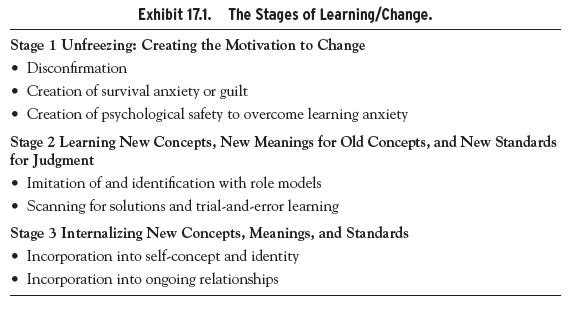The fundamental assumptions underlying any change in a human system are derived originally from Kurt Lewin (1947). I have elaborated and refined his basic model in my studies of coercive persuasion, professional education, group dynamics training, and management development (Schein, 1961a, 1961b, 1964, 1972; Schein and Bennis, 1965). This elaborated model is shown in Exhibit 17.1

All human systems attempt to maintain equilibrium and to maximize their autonomy vis-a-vis their environment. Coping, growth, and survival all involve maintaining the integrity of the system in the face of a changing environment that is constantly causing varying degrees of disequilibrium. The function of cognitive structures such as concepts, beliefs, attitudes, values, and assumptions is to organize the mass of environmental stimuli, to make sense of them, and to provide, thereby, a sense of predictability and meaning to the individual members (Weick, 1995; Weick and Sutcliffe, 2001). The set of shared assumptions that develop over time in groups and organizations serves this stabilizing and meaning-providing function. The evolution of culture is therefore one of the ways in which a group or organization preserves its integrity and autonomy, differentiates itself from the environment and other groups, and provides itself an identity.
Source: Schein Edgar H. (2010), Organizational Culture and Leadership, Jossey-Bass; 4th edition

I?¦m not sure the place you are getting your information, however good topic. I needs to spend some time learning much more or understanding more. Thanks for fantastic information I was in search of this information for my mission.